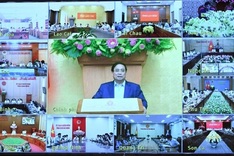 German pharmaceutical giant Bayer Schering Pharma AG said Friday it will invest heavily in Asia by doubling its sales team in India and tripling its workforce in Vietnam and that it plans to increase its sales by above market average growth rates in the region in the long-term.
German pharmaceutical giant Bayer Schering Pharma AG said Friday it will invest heavily in Asia by doubling its sales team in India and tripling its workforce in Vietnam and that it plans to increase its sales by above market average growth rates in the region in the long-term.
The company unveiled a strategy for growth in the region at its annual Asia Pacific press conference in Singapore.
"Our aim is to become stronger in the market and to have the support to be able to grow above the market and that is what we focus on," the company's Asia Pacific head, Alok Kanti, said.
Mr. Kanti said Bayer Schering plans to double its sales team in India, a market that he said currently makes up only a small part of the company's sales.
He said the company is currently considering a specific acquisition in India, but added more broadly that inorganic opportunities in that market remain "limited."
In other parts of the region, the company is targeting a sixfold increase in sales in Vietnam by 2015 and a tripling of the workforce there.
It also aims to become one of the top three pharmaceutical groups in South Korea by 2013 and among the top 10 pharma groups in India by 2015. The firm has plans to increase its South Korea staff by 20%.
Bayer Schering Pharma Asia Pacific Head of Global Medical Affairs Richard Nieman said the company plans to synchronize it Asia product development with the U.S. and Europe, which will mean products are released in Asia the same time they hit Bayer Schering's traditional markets.
Bayer Schering Pharma's sales in Asia Pacific, which excludes Japan, grew 13% to €1.04 billion in 2009. Asia sales represent 10% of Bayer Schering Pharma's global sales.
The pharma group's sales in the region in 2009 were driven by products such as the Yaz oral contraceptive pill, Nexovar oral anti-cancer medication and the antiplatelet AspirinCardio.
Bayer Schering Pharma to invest heavily in Asia
German pharmaceutical giant will invest in Asia and increase its sales by above market average growth rates in the region in the long-term.
Source: The Wall Street Journal




















